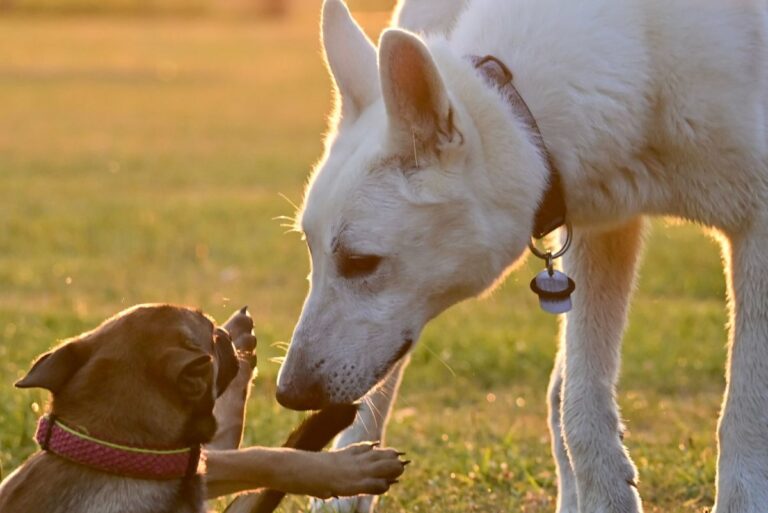Understanding dominance displays between dogs is crucial for pet owners to decipher their pets’ behavior. When one dog shows dominance to another, it can be a complex and multifaceted interaction. This behavior is a way for dogs to establish a hierarchy and maintain order within their social structure. Dominance displays can include growling, staring, posturing, or even physical acts to assert dominance.
Recognizing these signals is important to prevent potential conflicts between dogs. By learning to interpret and manage dominance displays, pet owners can create a harmonious environment for their furry friends. In this blog, we will delve deeper into the dynamics of dominance displays and provide insights on how to handle such situations effectively.
Understanding Dominance in Dogs
Dominance in dogs is a natural behavior that stems from their ancestral roots as pack animals.
When one dog shows dominance to another dog, it is often a display of asserting their position within the pack hierarchy.
Causes of Dominance Display
Dominance displays can be triggered by various factors such as competition for limited resources like food, toys, or attention.
It can also be influenced by the individual personalities and temperaments of the dogs involved.
Body Language Cues
When a dominance interaction occurs between dogs, there are specific body language cues to look out for, including:
- Direct eye contact
- Standing tall and stiff
- Showing teeth or snarling
- Blocking the other dog’s movements

Types of Dominance Displays
When it comes to dogs showing dominance to another dog, there are several types of dominance displays that can be observed. Understanding these displays can help in managing and preventing conflicts between dogs.
1. Aggressive Physical Displays
Dogs may use aggressive physical displays to assert dominance. This can include direct staring, standing tall and stiffening their posture, bearing teeth or snarling, and making themselves appear larger than the other dog.
2. Vocalizations
Another common dominance display is through vocalizations. Dogs may growl, bark or howl to communicate their dominance to another dog. These vocalizations are often accompanied by other non-verbal cues of dominance.
3. Resource Guarding
Dogs may exhibit dominance by resource guarding. This can involve protecting items such as food, toys, or sleeping areas from other dogs. Resource guarding is a way for a dog to show its status and establish boundaries.
Body Language Cues to Look For
Understanding body language cues in dogs is crucial in deciphering their communication patterns, especially when it comes to dominance displays. When one dog wants to assert its dominance over another, specific cues can indicate their intentions. These cues can vary from subtle to overt, but being able to recognize them can help prevent conflicts and ensure a harmonious interaction between dogs.
Direct Eye Contact
Dogs showing dominance to another dog often maintain direct eye contact as a way to assert their position. A dog staring intently at another without averting its gaze may signal a challenge or a display of superiority. This behavior can escalate tensions between dogs if not diffused.
Body Posture
A dominant dog typically stands tall with an erect posture, appearing confident and assertive. They may puff up their chest, raise their tail high, and hold their head up high. On the other hand, a submissive dog might cower, tuck its tail between its legs, or lower its body to appear smaller.
Facial Expressions
The facial expressions of dogs can also reveal their dominance or submission. Bared teeth, wrinkled muzzle, and a furrowed brow may indicate aggression or dominance. Conversely, a relaxed face with a soft gaze and slightly opened mouth can signify submissiveness.
Physical Gestures
Physical gestures such as mounting, putting a paw on the other dog’s back, or even gently nudging can be gestures of dominance. It’s essential to observe these gestures in context and consider the overall body language to interpret their meaning accurately.
Causes of Dominance Aggression
Dogs showing dominance to another dog can stem from various reasons, often related to their natural instinct and social hierarchy within a pack or household.
1. Resource Guarding
Dominance aggression might arise when a dog feels the need to protect valuable resources such as food, toys, or sleeping areas from other dogs, leading to displays of dominance.
This behavior can result from insecurity or fear of scarcity and is a way for the dog to establish control over important possessions.
2. Territorial Instincts
Dogs naturally have a territorial nature, and when one dog feels the need to assert dominance over a specific space or location in the presence of another dog, it can lead to aggressive behaviors.
- Marking territories through scent is a common form of asserting dominance.
- Competition for perceived territorial boundaries may trigger aggressive responses.
Frequently Asked Questions
- What is dominance display in dogs?
- Dominance display in dogs refers to behavior that one dog shows to another to assert their dominant position or establish hierarchies within the pack.
- What are some common behaviors associated with dominance display?
- Common behaviors associated with dominance display in dogs include growling, standing tall, mounting, blocking, stiff body posture, snarling, and maintaining eye contact.
- Is dominance display aggression?
- While dominance display can include aggressive behaviors, not all instances of dominance display necessarily lead to aggression. It is important to understand the context and triggers for such behavior.
- How should dog owners address dominance display between their dogs?
- Dog owners should focus on proper training, socialization, and providing structured interactions to manage dominance display between their dogs. Seeking help from a professional dog trainer or behaviorist may also be beneficial.
- Can dominance display be prevented?
- While dominance display is a natural behavior in dogs, proper training, socialization, and consistent leadership from the owner can help prevent excessive dominance displays and maintain a harmonious pack dynamic.
Final Thoughts: Understanding Dog Dominance
In conclusion, witnessing dominance displays between dogs can be a natural behavior rooted in their pack instincts. It is essential for dog owners and handlers to recognize the signs of dominance and establish themselves as the leaders to prevent aggression or conflicts. By understanding the subtle cues and body language that dogs use to assert dominance, we can better manage their interactions and create a harmonious environment. Remember, dominance is not about being aggressive, but rather about maintaining order within the pack dynamic. Building a strong bond based on trust and positive reinforcement is key to fostering healthy relationships between dogs and ensuring a peaceful coexistence.



